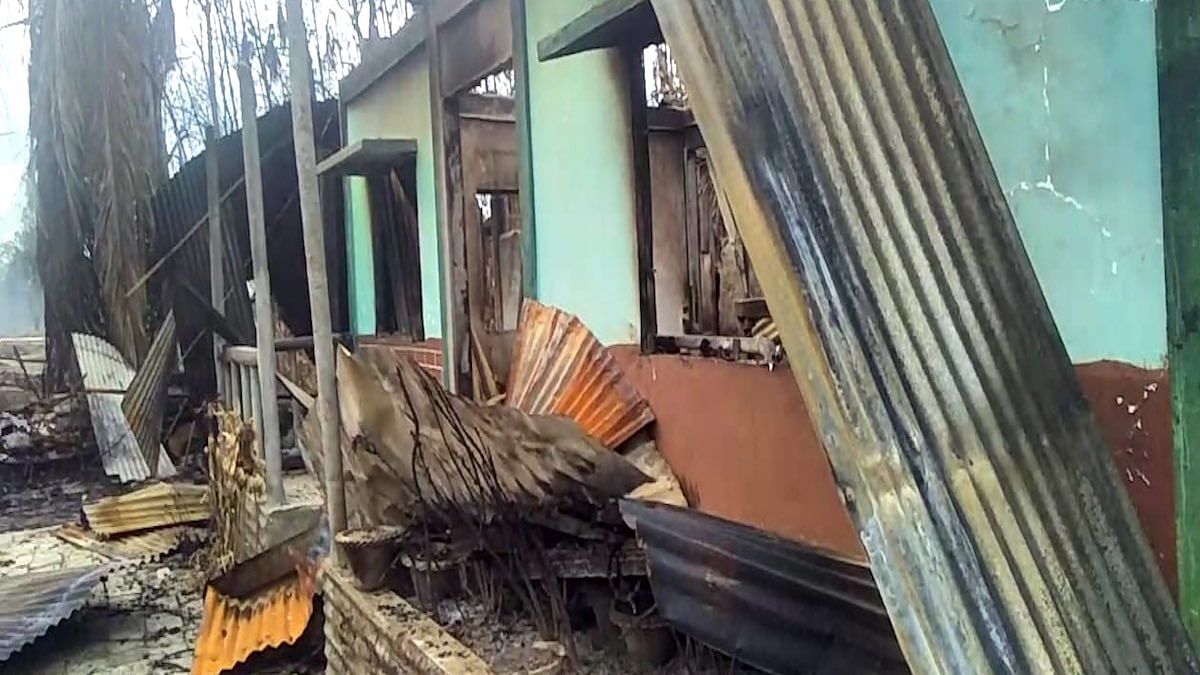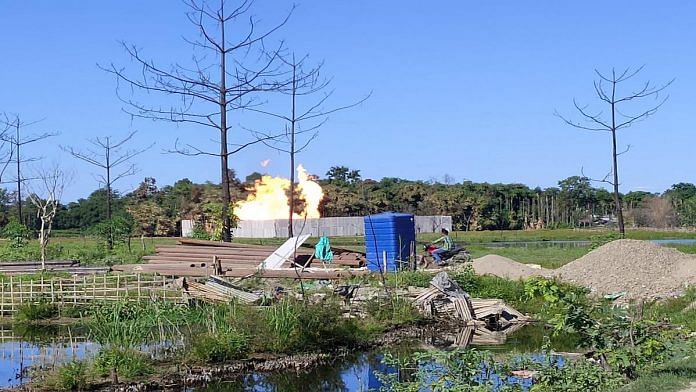Tinsukia (Assam): Tinsukia, a remote corner of Assam, is home to oil, tea, natural gas, coal and a rich biodiversity zone. But for nearly six months, night skies here lit up with an orange hue and an ash cloud loomed large over the pristine landscape.
Life has become hard on Tinsukia’s rural inhabitants after 27 May when the Oil India Ltd (OIL)’s oil well number 5 in the district’s Baghjan village exploded with a deafening noise. On 9 June, the well caught fire.
After burning bright for 170 days, the blowout — India’s longest oil well fire — was doused last month with experts from Canada employing a special ‘snubbing’ technique to cap the well. On 3 December, the PSU abandoned the well completely.
Baghjan Blowout Well finally abandoned. Consequent upon uncontrolled flow of Natural Gas & Blowout @ Baghjan well No 5 on 27 May 2020 OIL declared Emrgncy situation 4 its internal control purposes. 2day aftr final abandonment of d well, d Emrgncy declaration has been withdrawn. pic.twitter.com/VZfBKvQhpt
— Oil India Limited (@OilIndiaLimited) December 3, 2020
While the incident is now in the past, the villagers, who were evacuated to relief camps promptly, now complain of anxiety, damage to their ears, and respiratory illnesses.
Moreover, the rare Maguri-Motapung wetland and Dibru Saikhowa National Park, located next to the blowout site, have suffered long-lasting damage.
According to OIL, seismological studies have not shown any surface deformity in the region, but researchers say the public sector unit is downplaying the disaster that affected hundreds of families.
Last week, the Gauhati High Court stayed OIL plans to further explore oil wells in seven spots within the Dibru Saikhowa National Park.
Earlier, the National Green Tribunal (NGT) had directed the state’s Pollution Control Board to take legal action against OIL, besides revising compensation to affected families, on the recommendation of the Tinsukia deputy commissioner.
It had previously taken note of a report by the Wildlife Institute of India (WII), an autonomous institution under the Ministry of Environment Forest and Climate Change, which said no “restorative process” has been put in place.
In accordance with the NGT direction, the state government has proposed relief of Rs 25 lakh to 161 families and Rs 20 lakh to 439 families to affected families in Baghjan, said Assam Chief Secretary Jishnu Barua.
In the interim, the CM has directed compensation of Rs 15 lakh to 161 families and Rs 10 lakh to 349 families. OIL has deposited an amount of Rs 68.5 crore, which is being released to the affected people.
“The Government of Assam is most sympathetic towards the citizens affected by the unfortunate incident of the well blowout at Baghjan and regains full commitment to mitigating the suffering caused by the same,” Barua told ThePrint.
Also read: NGT decisions causing losses to industry, need to look at its mandate — ministerial panel
‘How do we live there?’
Troubles faced by villagers in this region go beyond just damaged homes and lost crops.
The WII report dated 15 July said the sound of the blowout travelled to 12 km and beyond. While sound up to 60 decibels (db) is safe for humans and animals, the blowout raised levels to between 72 and 112 db, thereby disrupting wildlife, birds and humans.
Putul Saikia, a local farmer, was among the worst hit. “On the night of the incident, we couldn’t fathom what this noise was as we could barely hear ourselves in our own homes… OIL officials evacuated us to camps nearby, and kept us away from our homes for nearly two weeks,” he said.
Saikia, who owned an orange plantation, a small tea garden and a fishery, has lost his home to the fire. While OIL has offered his family the highest compensation of Rs 25 lakh so far, Saikia is unsure how he will be compensated for the loss of livelihood and his wife’s poor health.
“My wife suffers from ache in the joints and severe headaches ever since… Medical care was basic and we haven’t understood why she gets these terrible pains… We can’t think of going back there now. Without bird song, animals and life that flourished around our home, how do we live there?” Saikia asked. He currently rents a home in Makum sub-division.

Other villagers in Baghjan also mention damage to hearing and ringing in the ears after the blowout.
Explaining the PSU’s healthcare support, Dilip Bhuyan, Chief General Manager (PA) and Head of Department, Public Affairs, OIL, said in an email: “OIL mobile health care team of doctors and paramedics have provided healthcare services to the impacted population since 27th May, 2020.” He also said patients were brought to OIL hospital in Duliajan and some were referred to hospitals in Tinsukia and Dibrugarh.
Wildlife damage
The lasting adverse impact is being felt on the rare Maguri-Motapung wetland and Dibru Saikhowa National Park — a rich biodiversity zone next to the blowout site.
Burnt trees of betel nuts, a major cash crop of the region, a natural pond overrun by vegetation, and a few birds are some of the visuals that can be spotted here now.
While most of the burnt land has been built over by OIL to divert oil and gas production to neighboring Makum, Baghjan and neighbouring Gottong villagers have deserted homes as riverboats and canoes remain static.
Oil and gas spillage into the Dibru river due to the blowout also endangers this delicate ecological zone, which is home to around 450 bird species, including over 200 migratory birds from lands as far away as Siberia and East Europe.
Maguri Beel (natural pond) has over 106 species of fish and multiple species of butterflies.
Residents of the hamlets that constitute the eco-sensitive and protected zone of Barekuri (in Tinsukia district) spotted thick oil coating on vegetation here, putting at risk the rare species of Hoolock Gibbons.
By the Dibru river, a Brahmaputra tributary, is the ecologically sensitive village of Barekuri, home to the endangered species of Hoolock gibbons. One died of liver and organ failure in October, raising fears over poisoning from the oil spillage.
To protect this rare and dwindling population of apes, local activists and residents continue to petition district authorities for better preservation after the disaster.
Also read: Unexplained tremors every 15 mins force over 1,000 near Assam’s Baghjan to leave their homes
The NGT action
On 3 November, a National Green Tribunal committee found that the Baghjan oilfield, apart from 26 other fields, was operating without mandatory environmental clearances when the blowout occurred.
This came after the tribunal fined OIL and its contracted subsidiary John Energy Ltd Rs 25 crore in June for the damage caused by the blowout and the subsequent fire.
A high-powered committee of the NGT under Justice (retired) B.P. Katakey also recommended payment of Rs 25 lakh to 173 families and Rs 20 lakh to 439 families identified by the district administration. The government proposal to revise the compensation came after this.
According to a report in Down To Earth, the panel also made interim recommendations seeking legal action against OIL for violating the air, water and environmental protection Acts.
However, Bhuyan said, “OIL has already carried out bio remediation through TERI, New Delhi and also physically collected the condensate that has spread in the nearby water bodies.”
He added: “The parameters of air quality was found to be within limits as per NAAQS (National Ambient Air Quality Standards) prescribed by CPCB as per findings of study report of M/s TERI, engaged for Ambient Air Quality (AAQ) monitoring.”
But environmentalists said OIL is downplaying the disastrous effects of the blowout.
Citing oil leak and leaching into rivers from previous blowouts at Naharkatia-Deohal and Dikom, the WII report said, “The entire focus seems to be closure of well and no restorative process has been put in place for remediation of effect of oil in terrestrial or aquatic system, it is left to nature to heal herself.”
Also read: Can plant traits be modified without modifying their DNA? Netherlands study says yes
Government steps
According to Chief Secretary Barua, different departments of the state government are taking a number of steps to aid the Tinsukia victims.
“Firstly, compensation to the people who have lost their homes and income sources is being provided with active support from Oil India through the district administration. Secondly, a holistic approach for sustainable development of the entire area aimed at upscaling the lives and economic status of the population is being planned and excellent,” said Barua.
“These include enhanced care facilities for human and animal health, upgradation of educational facilities, effective steps for combating food and erosion threats, providing financial assistance for self employment and capacity building of the youth of the area being some of the salient features,” he added.
According to Barua’s office, the government is also taking several other steps, including development of Maguri-Motapung Beel as a tourist destination, rehabilitation of affected people for handloom and weaving, and establishing a model hospital at Baghjan.
(With Bismee Taskin)
Also read: Pigs, cattle, sheep — fatty residues on Indus Valley pottery shows meat-heavy diet: Study




This news of oilwell fire comes as a complete surprise. This news has not been reported in the mainstream media, especially the Print media in south India, much less any follow up news thereon. I consider this as a signal failure of the Media.